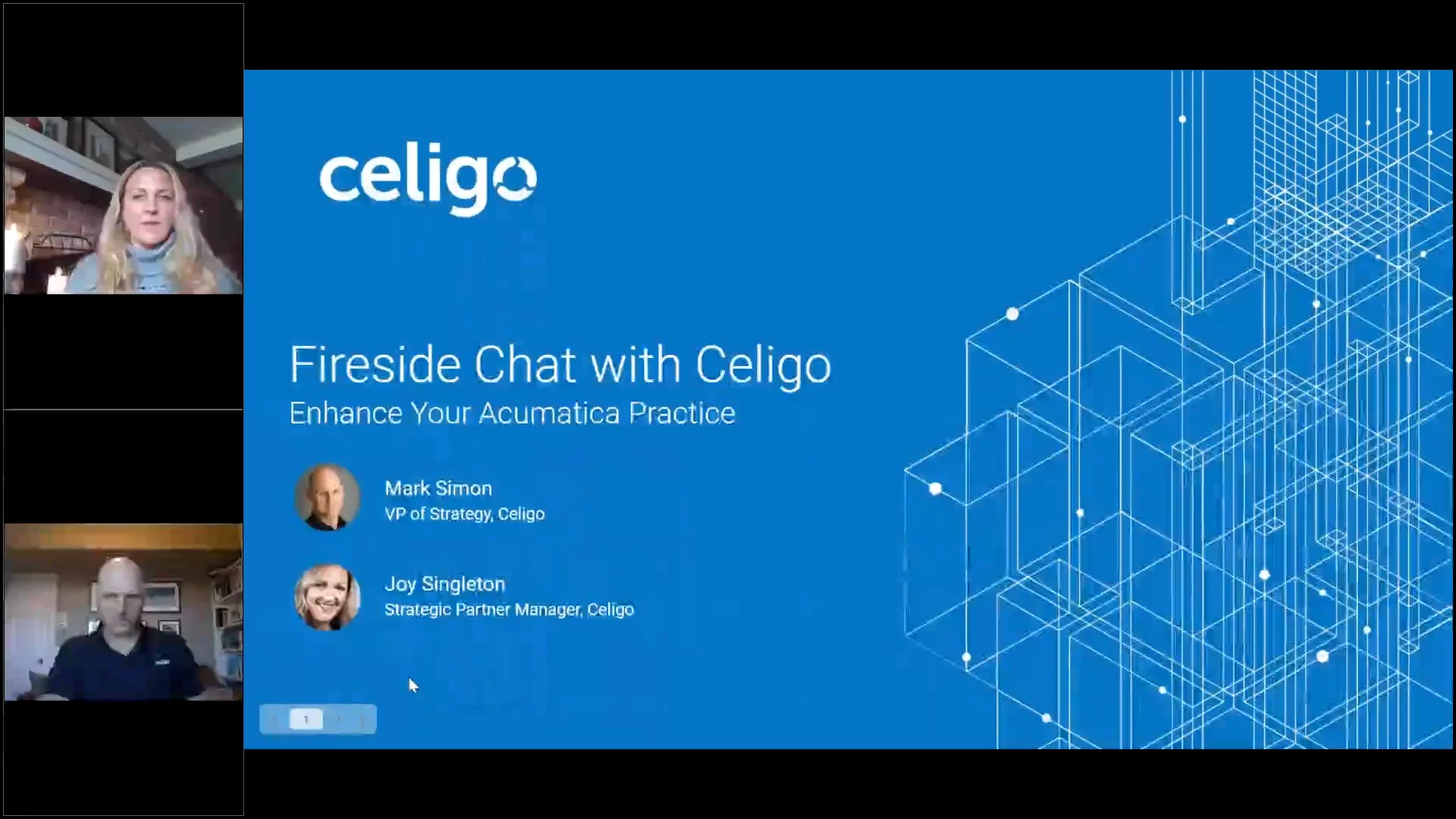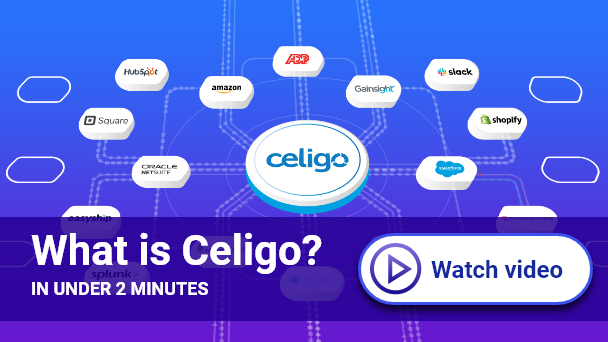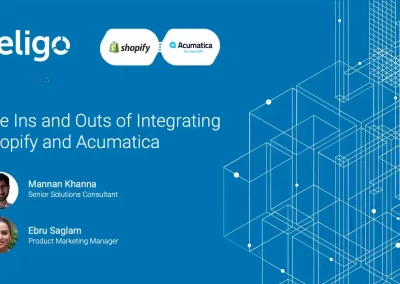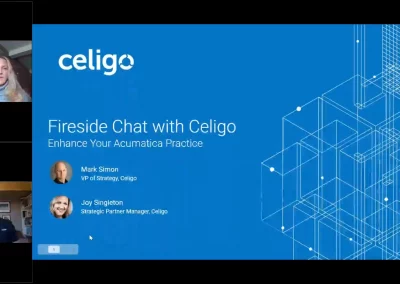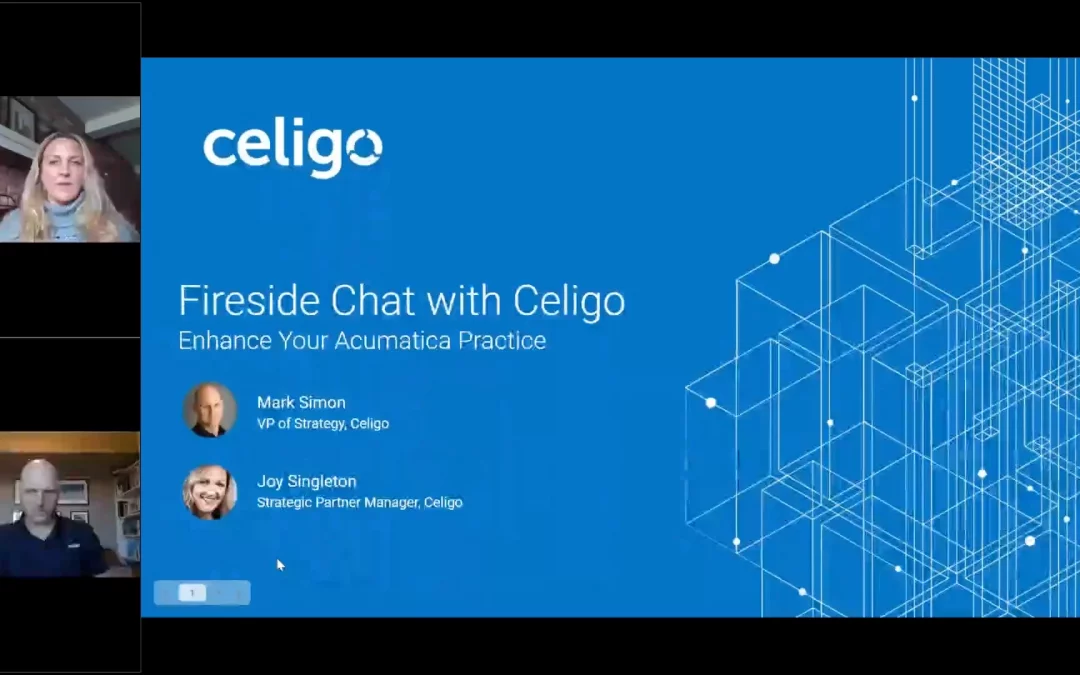Hello and welcome to your Fireside Chat with Celigo. I’m your host, Joy Singleton. I’m strategic partner manager here. And joining me today is Mark Simon, VP of strategy. We’re excited to be talking with you today. We’ve made some significant investments into the Acumatica ecosystem, particularly over the last year. We’re excited about the tremendous growth that we’re seeing in that ecosystem. And we look forward to working with your partners on that journey to help these customers streamline their operations and also help you engage your practice and create more efficiencies in your practice. We’ll first take you on that journey from a partner’s perspective with Mark. And Mark will talk about his time as a consulting partner and walk you through his experience with working with Celigo and how they use Celigo to enhance their practice. Then I’ll work through integrator.io and talk through some of the tools, resources available at your fingertips, particularly Celigo University. So then we’ll talk through where you can work with Celigo most and how to work with– how to identify the best use cases with Celigo and walk you through the partner program. And then we’ll finish with some questions at the end. Over to you. All right, thanks, Joy. Thanks, everyone. It’s a pleasure to be here speaking to everyone. I don’t have the great fireplace background like Joy does so you’ll have to bear with me. But it’s exciting to talk to everybody. I’ve been at Celigo for a couple of years. But I come from a background of SMB and mid-market consulting. I was in that space for about 12 years and in 8 of those leading a practice. And so I’ve actually spent a bit more time sitting in your shoes than I have on the software side. So in the practice that I ran, I had ERP development, e-commerce. But importantly for this conversation within the development practice, we had an integration team and really we were an integration shop from the very beginning. And we were really there for the evolution of integration solutions over the years and saw a lot of different things, what worked and what didn’t work, honestly. So even though I’ve been in the software ecosystem here at Explore for the last– or at Celigo for the last two years coming, it’s hard not to think of– I kind of forgot everything I learned at Explorer Consulting and not think of things from a practice leaders perspective. And that’s one of the things that’s really useful and I’m able to kind of help with the team is to help kind of remind everybody, “Hey, what does it look–? what does it look like to be building a practice in the ERP ecosystem? What’s important? How does integration play in?” So while we live and breathe integration here at Celigo, it’s easy to forget that for many of your customers and partners out there, integration isn’t your focus. It’s honestly sometimes a necessary evil evil, so to speak. If we think of building a house, everyone’s often preoccupied with the finishing features and how to best take advantage of the view. But you can’t do that if you don’t have a strong foundation for that house. And if you have integration gaps, you’re not going to have a good foundation for the greater business solution for your client, and that’s really one thing that we see over and over again is a lot of businesses running into problems at every stage that you can think of their growth cycle coming back to integration and a lack of proper integration and very often a good toolset to approach integration. And as you’ve likely seen before, you can be focused on an Acumatica deal, focused on ERP is the driver for an initiative and a consulting engagement. Maybe there’s some customization that goes along with it, but things can get hung up through a gap analysis around integration. Well, how do we get this plug-in? How do we get that? And those can be– And I’ve personally seen how you can lose deals because of that because you don’t have a strong enough answer, you don’t build enough confidence with your prospective client around an integration solution. And that’s really one of the ways where Celigo fits in and can help you improve your practice. One of the things that I saw in my experience was we tried about everything with integration. So first started in there wasn’t a lot of great tools out there, especially to connect to SaaS applications, to modern apps. And while we were doing a lot of integration, we were building everything from scratch and essentially hand-coding. Well, that worked. We get projects done. They were expensive. They often took a while to get launched and customers struggled to manage them. And that really impacted the customer’s ROI and business outcomes. And then as we evolved, we tried to build our own solution. I will recommend against that unless you are dedicated to being a product company of which we weren’t. But then finally, we kind of figure things out. And I looked at the space and I said, “Hey, everything’s headed in this direction of iPaaS. Or integration platform is a service and could see that the new generation of cloud-based platforms was something that we really needed to embrace in this in this SMB and mid-market ecosystem because time to value is so important. So having the best tooling is both a competitive advantage, but often a necessity. And we were simply getting– we were getting beat out on certain deals because our integration projects just we weren’t efficient enough. We couldn’t compete and deliver the same value that some of our competitors could. So we looked at the iPaaS solutions out there and Celigo ended up after assessing the field, selecting what was out there. Celigo was was our first choice. Yes, we actually ended up actually working with two simply because we had at the time Celigo was newer in the space and we had to add some very large customers that said, “Hey, this is what we’re using if you want the business.” And so it was a great opportunity because it gave me a first-hand opportunity to see how Celigo stacked up against some of the other solutions out there and one of the things we saw with this was– by going with Celigo, our integration practice changed dramatically. And by that, I mean if we take a typical integration project, we would have– our functional consultants would bill, say, 20% of the hours around the integration, and a developer would bill the other 80%. And we saw a similar– and that was when we were doing the work custom. When we worked with the other iPassS, a competitive iPassS solution, we saw about the same balance. But once our team got comfortable with Celigo, we saw that shift dramatically change, and we actually saw it flip, so that our functional consultants were doing 80% of the work around the integration, and the developers were only involved 20% of the time. And that was specifically because of the– a couple of things around Celigo. The ease of use of the platform. While we still have the power behind it, we could still do the more technical things. Our tech-savvy functional consultants could get in there, configure, and implement solutions and manage them. And we saw that creating a lot more efficiency in the practice and on the projects. Our developers were more expensive resources and harder to ramp, harder to train, and so this led to notably increased profitability around that practice and, honestly, more stability around it as well. Celigo also has strong pre-built solutions. Whether it’s templated solutions or integration applications, the strength of those pre-built solutions also really helped with that. We saw a lot of very common patterns. We had an e-comm practice, so we were doing a lot of work there, so. A lot of customers looking to connect in an e-comm platform or Amazon, for example, and being able to use a templated solution in there really got much quicker time-to-value for the customer. But again, those templated solutions are very accessible for the functional consultants and led to a strong, really strong, success rate and much quicker implementation time with improved margins from using those functional consultants. Because we didn’t need somebody with 10, 12 years of functional consult. We didn’t need the project lead to implement that. We could use one of the more junior staff who was familiar with the project, understood the integration, and gone through some training. They could get in there and implement. It can be a game-changer for a practice. It can really help increase your profitability and add another component to it, so. One of the things– one of the things I see sometimes is partners out there questioning, well, hey, we don’t we don’t want to do integration work. We’re focused on the business processes. We’re focused on the system implementation. This is what we do and where we’re focused. And I think if you’re not already realizing that you need to be able to address that integration work or that there’s an advantage to being– I hope I can help change your mind there. It’s something you should really consider. You’re talking to us today. You’re headed in that direction. But at least encourage you to think about the investment you want to make there. Because, definitely, in my experience over the– in more than 10 years. Saw that having strong integration capability in the practice directly help the ERP side. And so that’s one of the things that you can really look at. And you can start small, but quickly build those teams by using Celigo. And go with a platform. Don’t build it from scratch. I’ve been down that path. And you’re going to see a lot better profitability and margins through having a solution that’s platform based because you’re going to get repeated ability much more quickly. You’re going to be able to rebuild and reuse solutions. And then finally, the other thing too is that in SMB space, companies will often start out with only one or two systems. They’re starting kind of small. But with the proliferation of SaaS applications we’re seeing– getting more and more applications in a business earlier and earlier. And that brings that need for integration sooner than you expect. So by having that tool in your practice, by having a good solution, you’re going to be able to be ready for your client’s next stage of growth as well. And you’re going to be able to– you’re going to find that you’re going to have integration-only projects. They aren’t necessarily tied just to ERP, but associated with maybe a business system you don’t implement. But they come to you because now you can fill those integration needs. And it helps to stay engaged and stay in front of your clients over the long haul. So just to kind of recap here things that I’ve seen, and I think you should keep in mind for how Celigo can make a difference for you is, one, having a good solution, having a good integration plan ready to go, will help you close deals faster. When the gaps come up, you’ll be able to speak with confidence that you’ve got a good solution and get those gaps in the customer’s overall solution. You’re going to be able to minimize billable hour impact. So if you’ve got, no one wants to drag on billable time. The distraction of non-billable hours trying to figure things out, or where something goes awry. Using a platform, using more templated solutions, will reduce that margin risk when it comes to integration. Building this practice line, as we mentioned, can help generate more revenue for you. And you’re going to be able to offer just a more complete solution package to your customers. And in the end, this is maybe the most important thing. This is going to result in better business outcomes for them. Better business outcomes will get them a better return on investment. And that is just going to come back and justify the next round of projects, the next list of improvements to their systems and processes they want to make and bring you back into the fold again for the next round and help them kind of do that next effort sooner than they would otherwise by hitting that time to value earlier. So I hope this was kind of helpful for everybody. I’ve definitely seen a lot of integration actually be instrumental in an ERP power practice and really be a differentiator and game changer and I hope as you work with Acumatica, you’ll see the benefits of Celigo. With that, I’ll hand it back to Joy. Oh, sorry. [laughter] One more slide here. Apologies to everybody. So a little bit more about Celigo as an iPaaS platform. So I mentioned this earlier and the key thing to remember is that we’re an integration platform as a service, and that means we can connect anything to anything. So essentially, we’re a cloud-hosted solution. We sit in the middle and act as a hub between the systems for your customers. So we have the pre-built connectors that help connect anything that we’ve worked with before, that we’ve built out a connector that makes it faster. But we also have generic connectors so you can connect to anything, including legacy on-prem solutions or the latest SAS apps that have just come out or just launched in API. So we can really cover that ground. So we have that foundation of all those pieces. And then on top of that, we put the pre-built integrations on top of that in– take your increase, your velocity to build a solution and get time to value for your customer increase even further. And with that, I’ll hand it over to Joy. Thank you, Mark. So with that, I want to give you a tour of integrator.io. I’m going to take you into the tool itself and talk about some of those resources that Mark was referencing. So to begin, let’s go to our website. You can access an integrator.io by visiting www.Celigo.com. As it’s a pure cloud platform, everyone can sign in directly from our website. And if you haven’t already, please go and try it for free. You can set up a free trial pretty instantaneously just by clicking the free button here. But I’m going to go ahead and log into my Acumatica demo account. And when I first come in here, you’ll see all of my active integrations in a comprehensive view so that I can quickly monitor and see the health of all of my integrations. And this is the home dashboard that we’re looking at. Over to the toolbar, there’s a tool kit where you can go to build integrations and utilize several tools for building the resources, which is the foundation for building those integrations. The Help Center to give you access to support and help you find articles on specific topics. And Celigo University where you can learn to get certified and learn how to use the tool from the most simple tasks and more complex. And then the marketplace, which showcases all of those pre-built templates that Mark was referencing earlier. So to take you a little bit deeper, let’s go and look at this subset of integrations here that I have between Amazon and Acumatica. As you can see, there’s one error there that we’ll go ahead and look into that a little bit further. So initially, we’ve got a look of all the subset of integrations that I’ve got between these two applications. And we define these as a flow. And a flow is defined as a one-directional set of information from one custom object of an application to another custom object of an application. And just looking at this flow here, you can see when I last ran it. You can actually go in and edit the mapping real-time, make tweaks and changes as you go. One sec here. And then you can run a schedule. You can change the frequency of when you want to have that integration run. Just have to move my box here because it’s in my check box. And then you can run that integration at any time by just pressing the run button and then turn that integration on or off as needed. Sometimes you might need to just run integration for a brief period of time and then maybe turn them back on later. Additionally that dashboard, this is where we would go to actually resolve that error. So as you can see here, I’ve got several successful running integrations, but this one had failed. So if I want to go and view what that error is, I can get more information by just clicking into the dashboard here. It will tell me that this error has occurred because items not found. So let’s just pretend I went back into Acumatica and added the item then I can come back here and resolve that error. And then I will have all my integrations at success. So just going to select those and hit resolve. And it’s that easy to go in and do some error checking. For the connections, this will show us where the APIs are and what APIs we’re utilizing between those two endpoints here you see Acumatica and Amazon. I can set up notifications that if I want to receive a particular error on just a particular set of integrations, I can do that from here. There’s an audit log, so of all the users that have access, I can see who is making changes and at what time and to what integrations they’ve made those changes. I have the different users listed here, and I can enable or disable them and I can also invite additional users. Lastly, I can call this integration what I want, but then I can also clone this integration, which is particularly common with Amazon, where you might have multiple stores or multiple clients using the same integration, and you can clone the same integration functionality over and over again. So that should give you a kind of brief idea of how to manage integrations ongoing and how easy it is to pass over the keys to your clients to manage and maintain moving forward. As you can see now that error has moved to a success and now I’ve got all of my integrations working again. So let’s talk about building an integration and what that might look like. So, going into the tool kit, I’ve got to access the full builder, and this is where Mark was referencing where we’ve built all those really great pre-built connectors. Acumatica, of course, is in there, and all the major players across the marketplaces. You’ll see Amazon, Shopify, Zendesk, Google Shopping, marketing applications like HubSpot. And if you don’t see of the 200 which– there’s thousands out there. We can always work with FTP or Wrapper, or any API as well, but the building blocks are there. Having the connection there and having worked through the API already for you saves you hours of time in building those integrations. And that’s fundamentally the start. From there, you have some additional resources. The data loader, which might be used as a one-off situation to do data migrations and do simple CSV uploads. The DEV Playground gives you access to more advanced tools to do things like handlebar expressions, JavaScript editing or transformations. The resources you’ll have access to, the building blocks of your integrations to the different connections that you’re using. These are the different connections I’m using across the board in this instance, and then the different scripts I’m using, different agents, and then even the API tokens are listed here. So I can have access to those and reuse them over and over again. The help center. The three keys in the help center are where to go for general troubleshooting and go to find in the search functionality. What’s new? We launched integration updates. Integrator .IO updates quarterly, so you can see the latest and greatest advancements there. A lot of times, when you pop into IO, it’ll give you a general tour of what’s new if something has been recently updated, and then you can always submit a ticket. All of our customers have access to support and can play support tickets at any time. Every Celigo subscription comes with support. So let’s go to the help center here and see what we can find if we search for Acumatica Salesforce. For Acumatica Salesforce, the first thing that comes up is how to install a quick start pamphlet. And this is a template that has been used multiple times. So we find they’re the most common use cases between Salesforce and Acumatica. And by scrolling here through this article, you can see that it gives you step-by-step instructions about how to utilize, how to install, and how to work with this template. And then there’s some other adjacent articles that might be similarly helpful on the similar topic. Additionally, to expand your your knowledge and how to work with Celigo, we’ve launched Celigo University. And this is what I’m really excited about. Since its launch in last July, we’ve launched four certification courses. And thousands of our partners, customers, and prospects have become certified. So you can easily access the certification content by going to the content library, selecting learning paths, and then going down and selecting integrator.io. And this will give you access to the certification courses that we have. And most recently, we also launched a developer course as well. All of these courses, again, are free and available to anyone who comes in and creates their own integrator.io account. You could set up an account and start on course one today if you like. So as you can see here, you’ve got some of the basic fundamentals of working with the platform all the way up to more advanced skill sets of working with EDI and working with Scripps. Now, two important things to note here that as a partner, any one of your consultants getting certified at level two will be able to create their own demo account, which can be utilized in the future for proof of concepts and general training and demoing purposes for your use with your customers. Additionally, obtaining level four certification will provide your consultant with access to our partner office hours. And those partner office hours are available for 30 minutes at a time, one on one with a trained Celigo solution consultant who can give you best practice advice, guidance, or help you troubleshoot as you’re working with io and building flows for your customers. So, again, some great perks there available to you on-demand as you need it when you need it, Celigo University. And then the last piece here I’ll take you to is the Celigo marketplace. And that’s where you can access all those pre-templated flows that we’ve been talking about with Acumatica. So, currently, we’ve created a subset of about 20 or so plus, 20 or so across multiple different applications, a lot of them e-commerce. And this will grow exponentially throughout the year as we have more partners, more customers needing integrations, and more of our partners become equipped with the development tool. So let’s just take, for example, the Salesforce Acumatica template here and click to install that template. Now, again, you’ll see a subset of flows that are available. These are the most common use cases that we find our Salesforce users need between ERP. You can see here the first one listed as Acumatica contacts to Salesforce contacts and a short description of what that entails. You can use all of these integrations or one of these integrations. Utilizing the template just gives you a leg up on shortcutting the integration process. So if I go and install that integration this integration template, what you’ll see is I’m prompted to do my configuration to both endpoints, Acumatica, and Salesforce. And then I’ll be able to actually install this template from [inaudible]. And that, my friends, is kind of the soup to nuts of integrator.io, really high level. But, hopefully, you saw some fun and exciting things there that might encourage you to go out and try out the tool yourself and get started hopefully today. So with that, I will go back to taking you through how you might want to partner with Celigo and what our partnership program is all about. So first and foremost, our partnership program is free; no cost to join. We want everyone to become a partner, even if you only have one client need today, become a partner because that could lead to more business tomorrow. Celigo University that we talked about, again, free. Go in there. Get started run level one, set up your free trial account, and obtaining level two, like I said before, will give you access to that partner demo account. We have a ton of resources available in our partner portal. Once you become a partner, we’ll give you access to that portal along with all sorts of marketing assets that you can co-brand and utilize at your disposal. Again, when you want it, on-demand when you need it. And additionally, we back all of our workings with our partners with a strong sales enablement and solution consultant and marketing team. So you’ll have, from the beginning, from when you register that lead, you’ll have an experience of ease of lead registration through to approving the registration, introducing you to a Celigo partner, manager, that will talk you through what are your goals with this client and what are the outcomes, how do you want to work together on this particular engagement. And then introduction to a Celigo account executive who will help facilitate the sales process, involvement in demos, contractual agreements that are needed, and then wrap up the sale with you. And then we’ll hand you off to our enablement team if you choose to do the route yourself, and our services team if you choose to leverage one of our service engagements. Additionally, those Acumatica, the Acumatica connector, and all the 20 templates are available in your demo account for free. And they’re available to your customers to use as long as they have the endpoints available in their subscription. So from a partner perspective, we essentially have three different facets of working with us, and many of our partners might be one or two of these or just be one. Some of our partners are all three. But in general, we have the referral program, the third-party developer program, and our service partner program. And the referral program is the lead generation where we’re giving you a kickback for referring business our way. There’s a general referral program that provides a 10% commission on any closed subscription with us and there’s no commitments [inaudible] in that program. But it’s just our way of thanking you for referring business our way. The channel program is a little bit more involved. There’s a level of commitment there. The silver level is obtaining business of 40,000 or more a year with your partner community or with your customer community. And then as kickback, we double the commissions and also pair you with a strategic partner manager who can help facilitate more sales and do more business together. I’ll work on different strategies together to [inaudible] create more business. A third-party developer program, we’re really excited about that. We’ve recently launched this, and it’s by invite only, but this will allow our partners the ability to create their own IP so that they can create their own solutions on IO and then monetize that by launching those on our marketplace so again look for more coming your way about that, and if you’re interested in that, please let us know offline and we can talk about that further. The service partner program again, invite only. We have a few service partners today and we’re always looking for more. Service partners are invaluable. They help us really scale and grow our customers and with service partners, we’re looking that they have at least four certified consultants at a level four or higher, an Integrator.io, and that that bench is available to work within about a two-week lead time or so, so those are our different partner relationships that we have contractually, and if you’re interested in any more, you can ping us here at the end or drop a line to
[email protected], so let’s talk about when is the right time to bring in Celigo or what opportunities might present itself when Celigo might be a better fit. As you know, Acumatica has an awesome marketplace where there’s lots of native integrations already there, but with the plethora of applications available in the market, millions available and more being available every day, it’s impossible to keep up with native solutions for all of those apps, so that’s where Celigo can really come in. When there is no native solution available, we can help fill the gap. We can connect through, as I mentioned before, any connectivity method and build off in immigration to that application. Sometimes the native solution exists, but it doesn’t meet all the requirements. For example, we worked with a Salesforce client who really wanted to stay with Salesforce and they were both evaluating Acumatica and Sage Intacct, and it turned out that because we were able to show them the functionalities that they needed with Salesforce was actually bringing the financials back into Salesforce for their sales team. We were able to demonstrate that proof of concept working with a partner, and the partner was able to win that business over from Sage, so another winning way of where just meeting holistically the client’s requirements can help bring in more business together. In this time where all of our business is transacting online and communities– our manufacturer distribution clients have to do a pivot to e-commerce and streamline their operations quickly and efficiently. They might have to do it across multiple applications in the supply chain. You might have a contract manufacturer 3PLs, multiple e-commerce websites, Shopify, Amazon, big commerce, and they might have to do this all at once and relatively quickly, so being able to manage multiple applications and integrate them in one application in one place brings a big convenience for that client. You might run across an [ISP?] partner or application that you work with your clients on a regular basis, something like Concur. Concur actually came to Celigo because they wanted in integration with Acumatica, and we helped build them one. And that’s what you’ll find with the concurrent templates that are available in IO today. So if that presents itself while you’re out there talking to your customers, please bring those our way. We can help work with those engagements. Additionally, sometimes there is a common need to just build out an API because it might just be one integration, but long term that can be complex and hard to manage. I hope I’ve shown you today how easy it is to go in and manage integrations through the dashboard and give those keys to your clients to manage and maintain so that they can be the owners of their own experience ongoing. So that’s just the tip of the iceberg of when you might want to work with us or bring a client to us, and we can work together on collaborating on what that should look like and what kind of engagement we can do together there. So as Mark mentioned, we are seeing clients come to us earlier and earlier. It used to be our sweet spot was kind of right around that $10 to $25 million mark, where customers were at a peak point in their business where they had to scale in order to do more business. But now we’re seeing it right away, really early on, where they just want an application integration between two things that are very business-critical to that. And so that might start as early as the $5 million mark for some of these clients. Obviously, as we talked about today, wholesale distribution, service sectors, software companies, these are all great prospects for us, although we can work through any vertical. Hopefully, you’re seeing some names here that you recognize, like Kevins Worldwide or Gabriel or Digital Fortress. All of these are our customers today, facilitating and using our tools with integrations from Acumatica. And we’re geared towards the mid-market space, that’s where we want to be. We want to be the top iPath in that space and GQ has validated us for that in 2021. We were awarded the top mid-market [inaudible] iPath for 2021. And this is a survey that is where our clients are writing about using Celigo and how they benefit from using Celigo, and they’re writing about their experience directly. So we feel that that’s invaluable and speaks volumes for our customers that are out there. We don’t volunteer them to do that. They go out there and do that willingly to provide feedback to other users that are in the market for looking at iPath. Again, we’re Acumatica and certified on the latest and greatest R1 2021. And we’ll continue to keep updated as Acumatica makes updates as well. And if you feel so inclined or if you use the platform and you enjoy it and really love it, but only if you love it, feel free to go to [inaudible] and write your own review. Before we go, I want to leave you with a couple of reference stories, one from a customer, Gabriel Cosmetics. So they came to us early on, before there was native integration available with Acumatica. Jenna was really nervous about getting prepared for the thousands of orders that were going to come in through Black Friday and being prepared for the holiday season. She knew that she needed to invest in the right tools in order to successfully make it through that part of the season. So we were able to do that with our Shopify Acumatica template and to utilize that and she was able to streamline operationally and ended up saving $30,000 for that first year of business. Additionally, I talked about it before, but Acumatica SalesForce Integration. The template is out there and available to use and is very common for our partners to utilize that due to some of the other capabilities that aren’t in the native app. You can hear it directly from Jason Rondeau, who is a technology consultant at Innovative Cloud. He likes the easy and intuitive nature of IO and is happy with the customer support experience that he’s received so far and ultimately feels that it meets all of his requirements for needing to build integrations. So I’m hoping that you’ll get out there and try IO today. If not, this week and get a feel for it. Come talk to us. We’re very eager to talk to you and work with the partner community. Hopefully, Mark had spoken to you and you benefited from understanding from the partner perspective how we’re helping our partners, how we’re making your customers more sticky. And at the end of that is about our customers. It’s about servicing our customers, making it easier for them to do business, and then they come back to us doing more business, and they refer us more business and we become reputable in the marketplace. So hopefully you’ve had a great experience here today. We appreciate your time. We are open for any questions that you might have. And again, you can submit anything to
[email protected] if you’re interested in pursuing an agreement or go online and find the partner form on the partner page.
